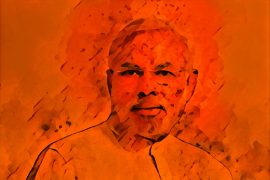At around 5.15 PM on Thursday, 22 December 2023, I had checked the scorecard of the third one-day international between India and South Africa. India had lost two wickets and, surprisingly, Sanju Samson had joined Captain K L Rahul at the crease. It was quite an unexpected move. Normally, the Indian team management did not put Sanju in the batting order. Then, I intuitively felt that Sanju would score a century in this match, and India would win the series. At that moment, I thought if that were to happen, I would write an article on Sanju. My intuition came true, and hence this article.
Soon after scoring his maiden international hundred for India at Paarl against South Africa, a beaming Sanju Samson flexed his muscles, showing his bulging biceps. The message was loud and clear for the powers that be of Indian cricket—that you cannot ignore his talent and skill, as they had been doing.
Sanju Viswanth Samson was born on 11 November 1994 at Pulluvila, a coastal village near Vizhinjam in Trivandrum, Kerala. As a cricketing talent, he is a right-handed batsman and wicketkeeper. After making an impact in junior cricket, he made his first-class debut for Kerala in 2011. He was the vice-captain of the Indian U-19 team. Though he was selected in India’s 17-man squad against England, he didn’t make it to the final eleven in any of the matches.
He made his India debut in the 2015 T-20 International against Zimbabwe and his one-day international debut against Sri Lanka. His Indian Premier League debut was in 2013 for Rajasthan Royals, and he won the Emerging Player of the Series. He scored an unbeaten 212 in the 2019-2020 Vijay Hazare Trophy, the second-fastest double-century.
In 2021, Sanju was named Captain of the Rajasthan Royals in IPL, and he scored a century in his first match as team leader and surpassed Ajinkya Rahane to become the all-time leading run-getter for Royals in 2022; his team did exceedingly well, though it lost the finals.
If you analyse his cricketing career, even though he was included in the Indian team in 2011, he has only played 15 matches in one-dayers. He is often included in the team only when the players like Rohit Sharma, Virat Kohli and other big names are not playing. His average is above 50, and his strike rate is over 101.
While his detractors question his consistency, selectors of the Indian cricket squad always find some reason to exclude him. When he played very well in the T20, the selectors included him in the one-day squad just before the T20 World Cup. The same pattern followed just before the recently concluded ODI World Cup also. He was asked to continue in Sri Lanka as a backup player, which ensured his exclusion from the T-20 squad for the Asian Games.
Ultimately, Surya Kumar Yadav, whose batting average is 25.8, almost half of Sanju’s average, was included in the team for the ODI World Cup. Surya scored a meagre 107 runs in 7 matches at an average of 17.67 in the World Cup. We also saw Surya’s frustration in the final against Australia.
If you look at the runs scored by Sanju, we can observe that he plays well while he bats in the top order—say as an opener or one down or two down, and that we have seen happening when he plays for Rajasthan Royals. But the Indian team management will send him in when the sixth wicket is down. He often has to bat with the tailenders. This always puts him in a dilemma, whether to go for quick runs or to stick around. This adds to the pressure on him. It then makes him try to start scoring from the very first ball.
One oft-quoted criticism of Samson is that he’s not consistent. His critics inside and outside the cricket establishment argue that he has been given many chances to play for the country but hasn’t utilised them productively. There’s an element of truth in this, too.
Even if it’s a second-rung team, Sanju had several opportunities to grab, but one finds that he didn’t utilise them fully. In Sri Lanka and, more recently, in the West Indies, he should have grabbed the chances that came his way to cement his place on the national team, but he squandered them with below-par performances. This is one area that Sanju will have to correct if he plays for India regularly, especially with many talented youngsters knocking on the BCCI doors.
In the recently concluded one-day series in South Africa, Sanju didn’t get an opportunity in the first match because of the low-scoring game; in the second, the entire team, including Sanju, failed. In the third match, Sanju has shown his class in full measure.
He took his time and didn’t go for any rash shot, but when the loose ball came, he played in his T20 style. He came out to bat in the 5th over of the match, held the Indian innings together with other players and scored 108 runs out of 114 balls in a very challenging situation.
Thanks to his brilliant knock, India put up 296 runs and helped defeat South Africa by 78 runs, winning the series 2-1. When Sanju scored his first century in his international career, I noticed a smiling and exciting face in the Indian dressing room, that of Yuzvendra Chahal, his Rajasthan Royals teammate, whom the selectors have also sidelined in recent times.
That Sanju has a considerable fan base in India and abroad is evident. Videos of Sanju fans putting up posters in various stadiums around the world in his support are quite common. In Paarl, too, many Sanju supporters held up banners encouraging him to show his skills.
K L Rahul’s observation is significant in the context of Sanju’s career: admitting that Sanju has been a ‘phenomenal performer in the IPL over the years,’ unfortunately, ‘we haven’t been able to give him the chance at No. 3, because obviously there are stalwarts in the ODIs who occupy those key spots.’ This is a challenge that Sanju will have to keep in mind, that he’s up against heavy odds and only consistency will pay for him.
Though all the former players and commentators praised Sanju for his match-winning performance and winning the Man of the Match award, one person ignored his performance, posted photos of Tilak Varma and Arshdeep Singh, and congratulated the Indian team. It is none other than a top BCCI functionary.
Sanju’s century and his brilliant performance have been a sweet revenge not only against his detractors but also against one person in particular, S. Sreesanth, his former Kerala/ Rajasthan Royals teammate who wanted him to be removed from the Royals Captaincy. Sreesanth has in the past accused Samson of an ‘attitude problem.’ However, he praised Sanju after the Paarl century, which is what his supporters and the cricket fraternity expect from him.
The India head coach, Rahul Dravid, who knows Sanju well, has been both an admirer and a critic. It was Dravid who brought him to Rajasthan Royals after seeing his talent, but the legend has often lamented that Sanju hasn’t lived up to his potential. Samson will have to seriously ponder Rahul’s criticism, what with Dravid in the midst of everything to do with the team composition.
Legendary cricketer Shane Warne, who captained and mentored the Rajasthan Royals, had spoken very highly of Sanju’s talent and felt that he was one of the brightest prospects for Indian cricket. Let us hope that Samson will get to play more games for the country and realise his full potential.
-30-
Copyright©Madras Courier, All Rights Reserved. You may share using our article tools. Please don't cut articles from madrascourier.com and redistribute by email, post to the web, mobile phone or social media.Please send in your feed back and comments to [email protected]











